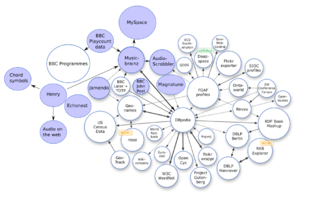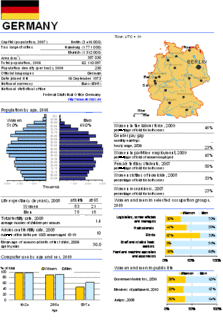
A census is the procedure of systematically calculating, acquiring and recording information about the members of a given population. This term is used mostly in connection with national population and housing censuses; other common censuses include the census of agriculture, and other censuses such as the traditional culture, business, supplies, and traffic censuses. The United Nations defines the essential features of population and housing censuses as "individual enumeration, universality within a defined territory, simultaneity and defined periodicity", and recommends that population censuses be taken at least every ten years. United Nations recommendations also cover census topics to be collected, official definitions, classifications and other useful information to co-ordinate international practices.
Statistics Canada, formed in 1971, is the agency of the Government of Canada commissioned with producing statistics to help better understand Canada, its population, resources, economy, society, and culture. It is headquartered in Ottawa.
Public health surveillance is, according to the World Health Organization (WHO), "the continuous, systematic collection, analysis and interpretation of health-related data needed for the planning, implementation, and evaluation of public health practice." Public health surveillance may be used to track emerging health-related issues at an early stage and find active solutions in a timely manner. Surveillance systems are generally called upon to provide information regarding when and where health problems are occurring and who is affected.
Statistics Canada conducts a national census of population and census of agriculture every five years and releases the data with a two-year lag.
Sri Lankan Canadians refers to people from Sri Lanka who have arrived and settled in Canada. Among these immigrants include members from the Sinhalese, Tamil, Moor, Malay and Burgher ethnicities. According to 2016 census there are 152,595 Sri Lankans in Canada.

Open data is data that is openly accessible, exploitable, editable and shared by anyone for any purpose, even commercially. Open data is licensed under an open license.
Health services research (HSR) became a burgeoning field in North America in the 1960s, when scientific information and policy deliberation began to coalesce. Also known as health systems research or health policy and systems research (HPSR), is a multidisciplinary scientific field that examines how people get access to health care practitioners and health care services, how much care costs, and what happens to patients as a result of this care. Health Services Research utilizes all qualitative and quantitative methods across the board to ask questions of the healthcare system. It focuses on performance, quality, effectiveness and efficiency of health care services as they relate to health problems of individuals and populations, as well as health care systems. Health Services Research addresses wide-ranging topics of structure, processes, and organization of health care services; their use and people's access to services; efficiency and effectiveness of health care services; the quality of healthcare services and its relationship to health status, and; the uses of medical knowledge.
Secondary data refers to data that is collected by someone other than the primary user. Common sources of secondary data for social science include censuses, information collected by government departments, organizational records and data that was originally collected for other research purposes. Primary data, by contrast, are collected by the investigator conducting the research.
The Ministry of Statistics and Programme Implementation (MoSPI) is a ministry of Government of India concerned with coverage and quality aspects of statistics released. The surveys conducted by the Ministry are based on scientific sampling methods.
GeoBase is a federal, provincial and territorial government initiative that is overseen by the Canadian Council on Geomatics (CCOG). It is undertaken to ensure the provision of, and access to, a common, up-to-date and maintained base of quality geospatial data for Canada. Through the GeoBase, users with an interest in geomatics have access to quality geospatial information at no cost and with unrestricted use.

Official statistics are statistics published by government agencies or other public bodies such as international organizations as a public good. They provide quantitative or qualitative information on all major areas of citizens' lives, such as economic and social development, living conditions, health, education, and the environment.
The Information Warfare Monitor (IWM) was an advanced research activity tracking the emergence of cyberspace as a strategic domain. Created in 2003, it closed in January 2012. It was a public-private venture between two Canadian institutions: The SecDev Group, an operational think tank based in Ottawa (Canada), and the Citizen Lab at the Munk School of Global Affairs, University of Toronto. The Principal Investigators and co-founders of the Information Warfare Monitor are Rafal Rohozinski and Ronald Deibert. The Information Warfare Monitor is part of the Citizen Lab’s network of advanced research projects, which include the OpenNet Initiative, the Fusion Methodology Centre, and PsiLab.

In 2021, the population of the city of Ottawa was 1,135,014, an 8.5% increase from 2016. The population of the census metropolitan area, Ottawa-Gatineau, was 1,488,307.
Open data in Canada describes the capacity for the Canadian Federal Government and other levels of government in Canada to provide online access to data collected and created by governments in a standards-compliant Web 2.0 way. Open data requires that machine-readable should be made openly available, simple to access, and convenient to reuse. As of 2016, Canada was ranked 2nd in the world for publishing open data by the World Wide Web Foundation's Open Data Barometer.
The social data revolution is the shift in human communication patterns towards increased personal information sharing and its related implications, made possible by the rise of social networks in the early 2000s. This phenomenon has resulted in the accumulation of unprecedented amounts of public data.
Health indicators are quantifiable characteristics of a population which researchers use as supporting evidence for describing the health of a population. Typically, researchers will use a survey methodology to gather information about certain people, use statistics in an attempt to generalize the information collected to the entire population, and then use the statistical analysis to make a statement about the health of the population.
Beyond 2011, also known as The Beyond 2011 Programme, is a project initiated by the UK Statistics Authority to look at the alternatives to running a UK census in 2021. In 2008, the Treasury Select Committee had expressed concerns about the increasing cost of running the census and inaccuracies in data gathered only every ten years. In 2010 the newly elected coalition government reiterated such concerns responding to a report by the UK Statistics Authority.
Civic technology, or civic tech, enhances the relationship between the people and government with software for communications, decision-making, service delivery, and political process. It includes information and communications technology supporting government with software built by community-led teams of volunteers, nonprofits, consultants, and private companies as well as embedded tech teams working within government.
The Canadian Census of Agriculture, is a census conducted every five years by Statistics Canada, alongside the national census, for the purposes of gathering Canadian agricultural industry, farm operator, and farm data.
Mydemocracy.ca is a public consultation commissioned by the Canadian federal government. It is intended to inform electoral reform. Replacing the existing first-past-the-post system with another voting system, before the next election, was a 2015 election promise.




